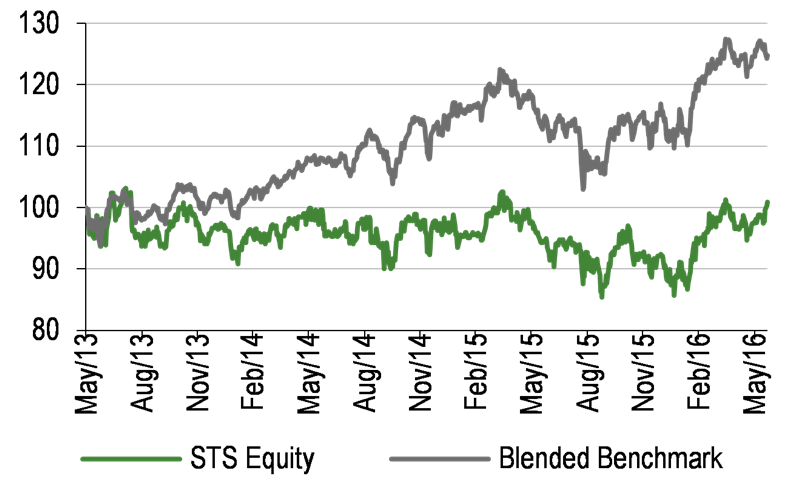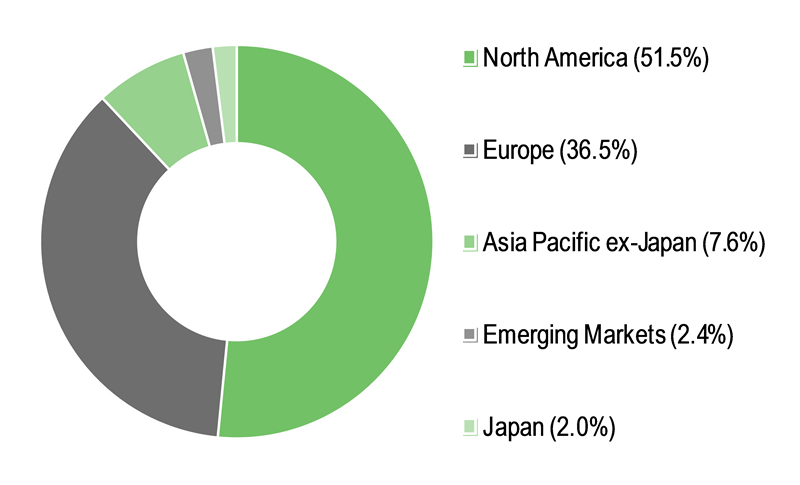Investment process: Focus on in-house research
Manager Mark Whitehead, who joined Martin Currie in late 2015, has built a dedicated equity income team of four portfolio managers (including former STS manager Alan Porter) and three specialist equity income analysts. All the portfolio managers also conduct research and analysis. The analysts have sector specialisms, and cover funds (such as private equity, infrastructure and real estate investment trusts) as well as operating companies; as a result, the STS portfolio may include some fund investments in future, although it will remain fundamentally an equity portfolio.
Research is key to the process. The team monitors the universe of potential investments, and the first step towards inclusion is an early-stage pitch to colleagues and Martin Currie’s wider global equities team, to debate whether a stock warrants further research. Ideas that get past this hurdle are modelled in a proprietary template, building five years of explicit assumptions using discounted cash flow forecasts or dividend discount models. Team members work closely with the management of potential holdings when building models, to ensure the output is both realistic and conservative. The team uses income metrics such as cash flow return on investment and free cash flow yield to compare companies across sectors and regions, and then ranks stocks in order of conviction.
Although STS has an income mandate, Whitehead says that assessing growth is the starting point when identifying investments. He argues that the value focus of many income funds can lead to capital and income volatility, as high-yield stocks can be at greater risk of cutting their dividends. The team seeks to identify genuine, sustainable growth, leading to a bias towards quality companies with strong franchises and management, a competitive advantage and the ability to convert revenue growth into growing free cash flow. Dividend growth is more important than a high starting yield, and positions may be taken in companies that are not currently paying a dividend, as long as there is a realistic prospect of their doing so in the near future.
A differentiating feature of the process is the team’s focus on credit analysis. Debt structures are analysed to ensure that companies have the financial autonomy to invest throughout economic cycles, and will not be forced to scale back operations in order to service debt in a rising interest rate environment. The team also stress-tests cash flows to assess a company’s ability to continue paying and growing its dividends. Whitehead says the most important factor is that companies generate sufficient organic cash flows to cover their dividends, and by stress-testing the models, the team can experiment with a range of possible economic and market conditions to gauge the impact on a firm’s ability to meet its obligations. STS also has a strong focus on corporate governance, predicated on the view that well-run firms perform better. Supported by Martin Currie’s dedicated head of governance and sustainability, the team assesses the quality of management and seeks to understand the structures in place to mitigate operational risk. The trust also votes at all investee company AGMs.
With a focused stock list of 35-55 stocks (43 across 14 countries at 31 May), only the team’s ‘best ideas’ will be included in the STS portfolio. Positions are sized based partly on conviction but also on an assessment of cyclicality and the likelihood of the investment thesis working; stocks deemed to be higher-risk may be given a lower weighting. There is no minimum position size and the maximum weighting in a stock is 7%. Risk is monitored by Martin Currie’s specialist risk team, not just in terms of volatility (measured by country, sector, stock and market capitalisation) but also liquidity and correlation between stocks.
Holdings may be sold if the investment thesis has played out successfully, or the thesis has been violated by factors such as a change in management or the competitive landscape, or simply if the team sees better ideas elsewhere. If a share price has fallen by 20% since purchase, the stock will be reviewed by someone other than the original analyst, and action taken – the position may be sold, but if the original thesis still stands, the holding may be increased. Portfolio turnover is expected to settle at 30-35% a year once the initial repositioning has been completed.
The manager may use options to enhance income or for efficient portfolio management. Covered calls may be written over holdings the manager wishes to sell, if sufficient near-term volatility is expected to generate an attractive premium. Put options may be written for stocks the manager would be happy to buy at a lower price. Maximum gross exposure will be 15%, and Whitehead says that throughout a cycle he expects to generate 5-10% of portfolio income through options writing.
Current portfolio positioning
Exhibit 2 below shows STS’s portfolio breakdown by sector at 31 May, while the geographical breakdown is shown in Exhibit 1 on page 2. The process of rebalancing the portfolio in line with the new investment process has so far been incremental, with the team working through all the stocks to see what they are happy to keep in the short or long term, or where they might seek a better idea. The manager expects there will be 10 new holdings by the end of his first half-year in charge. New investments include Airbus (bought in late 2015/early 2016 after the establishment of the new income team), which has a very high market share in the next generation of narrow-body aircraft that will help to meet increasing demand for air travel from emerging market consumers. Whitehead also expects to increase the proportion in smaller stocks – an example is recent purchase CTT Correios de Portugal (the Portuguese post office), which has a market cap of just over £1bn.
Exhibit 2: Portfolio sector exposure vs index (% unless stated)
|
Portfolio
31 May 2016 |
Portfolio
31 May 2015 |
Change
(% pts) |
MSCI World Index weight |
Active weight vs index (% pts) |
Trust weight/ index weight (x) |
Financials |
19.8 |
17.4 |
2.4 |
20.0 |
-0.1 |
1.0 |
Consumer staples |
16.9 |
13.5 |
3.4 |
10.8 |
6.2 |
1.6 |
Industrials |
16.2 |
11.7 |
4.5 |
10.9 |
5.3 |
1.5 |
Healthcare |
15.9 |
17.0 |
-1.1 |
13.1 |
2.8 |
1.2 |
Telecommunications |
8.3 |
7.4 |
0.9 |
3.6 |
4.7 |
2.3 |
Energy |
7.6 |
11.1 |
-3.5 |
6.6 |
1.0 |
1.1 |
Utilities |
7.2 |
5.3 |
1.9 |
3.4 |
3.8 |
2.1 |
Information technology |
5.4 |
2.5 |
2.9 |
14.2 |
-8.8 |
0.4 |
Materials |
5.0 |
7.1 |
-2.1 |
4.7 |
0.3 |
1.1 |
Consumer discretionary |
4.6 |
15.0 |
-10.4 |
12.9 |
-8.3 |
0.4 |
Cash |
3.7 |
1.4 |
2.3 |
0.0 |
3.7 |
N/A |
Gearing |
-10.6 |
-9.4 |
-1.2 |
0.0 |
-10.6 |
N/A |
|
100.0 |
100.0 |
0.0 |
100.0 |
0.0 |
|
Source: Securities Trust of Scotland, Edison Investment Research

















